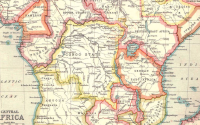Published on Thursday, January 9, 2003 by the Guardian/UKby Paul Brown The human race has only one or perhaps two generations to rescue itself, according to the 2003 State of the World report by the Washington-based Worldwatch Institute.
The longer that no remedial action is taken, the greater the degree of misery and biological impoverishment that humankind must be prepared to accept, the institute says in its 20th annual report.
Overuse of resources, pollution and destruction of natural areas continue to threaten life on the planet. Conditions continue to deteriorate rapidly, the report says, although there are some hopeful signs in that technical solutions to the problems have been found and - where there is political will - adopted. In most cases, though, nothing is being done.
Among the worst trends worldwide is that 420 million people live in countries which no longer have enough crop land to grow their own food and have to rely on imports. Around 1.2 billion people, or about a fifth of the world's population, live in absolute poverty - defined as surviving on the equivalent of less than $1, or 62p, a day.
About one quarter of the developing world's crop land is being degraded, and the rate is increasing. The greatest threat is not a shortage of land, says the report, but a shortage of water, with more than 500 million people living in regions prone to chronic drought.
By 2025 that number is likely to have increased at least fivefold, to between 2.4bn and 3.4bn. A probable world population increase of 27% over the same period will create social and ecological instability.
Global warming is accelerating, and carbon dioxide in the atmosphere has reached 370.9 parts per million, the highest level for at least 420,000 years and probably for 20m years.
Toxic chemicals are being released in ever-increasing quantities, and global production of hazardous waste has reached more than 300m tonnes a year. There is only a vague idea of what damage this does to humans and natural systems, the report says.
Another threat is the movement of highly invasive species to regions where they may pose problems to native species.
The state of the world's natural life support system is perhaps the most worrying indicator for the future, says the report. About 30% of the world's surviving forests are seriously fragmented or degraded, and they are being cut down at the rate of 50,000sq miles a year, it says.
Wetlands have been reduced by 50% over the last century. Coral reefs, the world's most diverse aquatic systems, are suffering the effects of overfishing, pollution, epidemic diseases and rising temperatures.
A quarter of the world's mammal species and 12% of the birds are in danger of extinction.
On the hopeful side, the report says that renewable energy technologies have now developed sufficiently to supply the world. They could significantly reduce the threat to the world from pollution - but currently there is a lack of political will to introduce them fast enough.
Another industry which causes widespread destruction, mining for minerals, could be largely replaced by re-use and recycling.
Mining consumes 10% of the world's energy, spews out toxic emissions, and threatens 40% of the world's undeveloped forests but these effects could be drastically reduced.
Another crisis which the report identifies is in the world's cities, where one billion people seek shelter in shanty towns, often on hillsides, flood plains, in rubbish dumps or downstream of industrial polluters.
The inhabitants of these settlements live at constant threat of eviction, but also of natural disasters and disease. Urban centers in the south now dominate the ranks of the world's largest cities.
Slum dwellers are organizing for greater rights and better lives, the report says. One of the great challenges for governments is to help their poorest citizens feel secure in their own homes, make a living and improve their environment.
Dark clouds, silver linings
Worst trends· Malaria claims 7,000 lives every day · Bird extinctions running at 50 times natural rate · Global rate of ice melt more than doubled since 1988; sea levels may rise 27cm by 2100 · New fishing technologies help to locate and further exploit declining stocks
Reasons for hope · Populations have stabilized in Europe and much of south-east Asia · Organic farming is the fastest-growing sector of world agricultural economy · Wind and photovoltaic electricity generating capacity to increase 30% a year for five years (1% for fossil fuels) · Production of ozone-depleting CFCs fell 81% in the 90s, slowing growth in ozone hole






